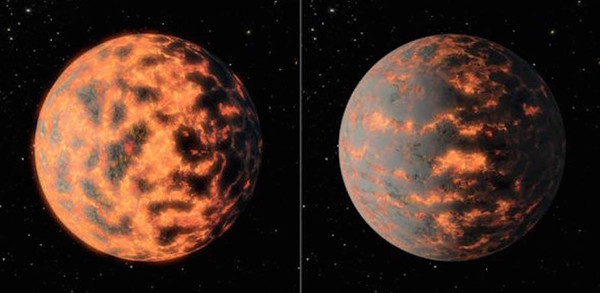Discovering new exoplanets has become rather routine in the last few years, but determining just what conditions exist on any of them is naturally more difficult, since they are so far away. But astronomers are making advances in this area as well, and now they have found the first evidence of changing temperatures – and possible volcanic activity – on a distant super-Earth exoplanet.
The new research was led by scientists from the University of Cambridge, using data from the Spitzer Space Telescope. Over a two-year period, they observed a nearly three-fold change in temperature on the planet. While the cause isn’t definitively known yet, it is thought that the temperature changes may be due to volcanic activity.
“This is the first time we’ve seen such drastic changes in light emitted from an exoplanet, which is particularly remarkable for a super-Earth,” said Dr. Nikku Madhusudhan of Cambridge’s Institute of Astronomy, a co-author on the new study. “No signature of thermal emissions or surface activity has ever been detected for any other super-Earth to date.”
The planet, 55 Cancri e, orbits a sun-like star 40 light-years away in the constellation Cancer. It is about twice the size and eight times the mass of Earth. Temperatures on the hot “day” side of the planet (as it is tidally locked to its star) were seen to wildly swing between 1,832 and 4,892 degrees Fahrenheiht (1,000 and 2,700 degrees Celsius). The surface may be partially molten, since it orbits very close to its star and its year is only 18 hours long, much closer than Mercury orbits our own Sun. Since it is tidally locked and doesn’t rotate, one side is always facing its star. The changes in temperature may be due to huge plumes of gas and dust in its atmosphere. If so, the planet may be highly volcanically active, even more so than Jupiter’s moon Io, the most volcanically active body in our own Solar System.
“We saw a 300 percent change in the signal coming from this planet, which is the first time we’ve seen such a huge level of variability in an exoplanet,” said Dr. Brice-Olivier Demory of the University’s Cavendish Laboratory and lead author of the new study. “While we can’t be entirely sure, we think a likely explanation for this variability is large-scale surface activity, possibly volcanism, on the surface is spewing out massive volumes of gas and dust, which sometimes blanket the thermal emission from the planet so it is not seen from Earth.”
55 Cancri e is the closest known super-Earth exoplanet whose atmosphere can be studied by astronomers. Previous observations had suggested the presence of a large amount of carbon on the planet, perhaps even in the form of diamond, but now the new findings have raised yet more questions.
“When we first identified this planet, the measurements supported a carbon-rich model,” said Madhusudhan, who along with Demory is a member of the Cambridge Exoplanet Research Centre. “But now we’re finding that those measurements are changing in time. The planet could still be carbon rich, but now we’re not so sure – earlier studies of this planet have even suggested that it could be a water world. The present variability is something we’ve never seen anywhere else, so there’s no robust conventional explanation. But that’s the fun in science – clues can come from unexpected quarters. The present observations open a new chapter in our ability to study the conditions on rocky exoplanets using current and upcoming large telescopes.”
Super-Earths, larger than Earth but smaller than Neptune, are now thought to be one of the most common exoplanets in our galaxy, even though there aren’t any in our Solar System. Most are likely to be rocky like Earth, but probably vary widely in other characteristics. Some are thought to possibly be true water worlds, completely covered by oceans. 55 Cancri e is much too close to its star to have much if any water, at least on its surface, but it does give astronomers a chance to study one of these truly alien worlds in more detail.
No one knows yet what 55 Cancri e actually looks like up close, but if Io is any indication, it may be very interesting indeed. Io is so volcanically active, its entire surface looks like a multi-colored sulfuric pizza and the moon has been essentially turning itself inside out over eons; it is one of the most visually stunning places in the Solar System.















